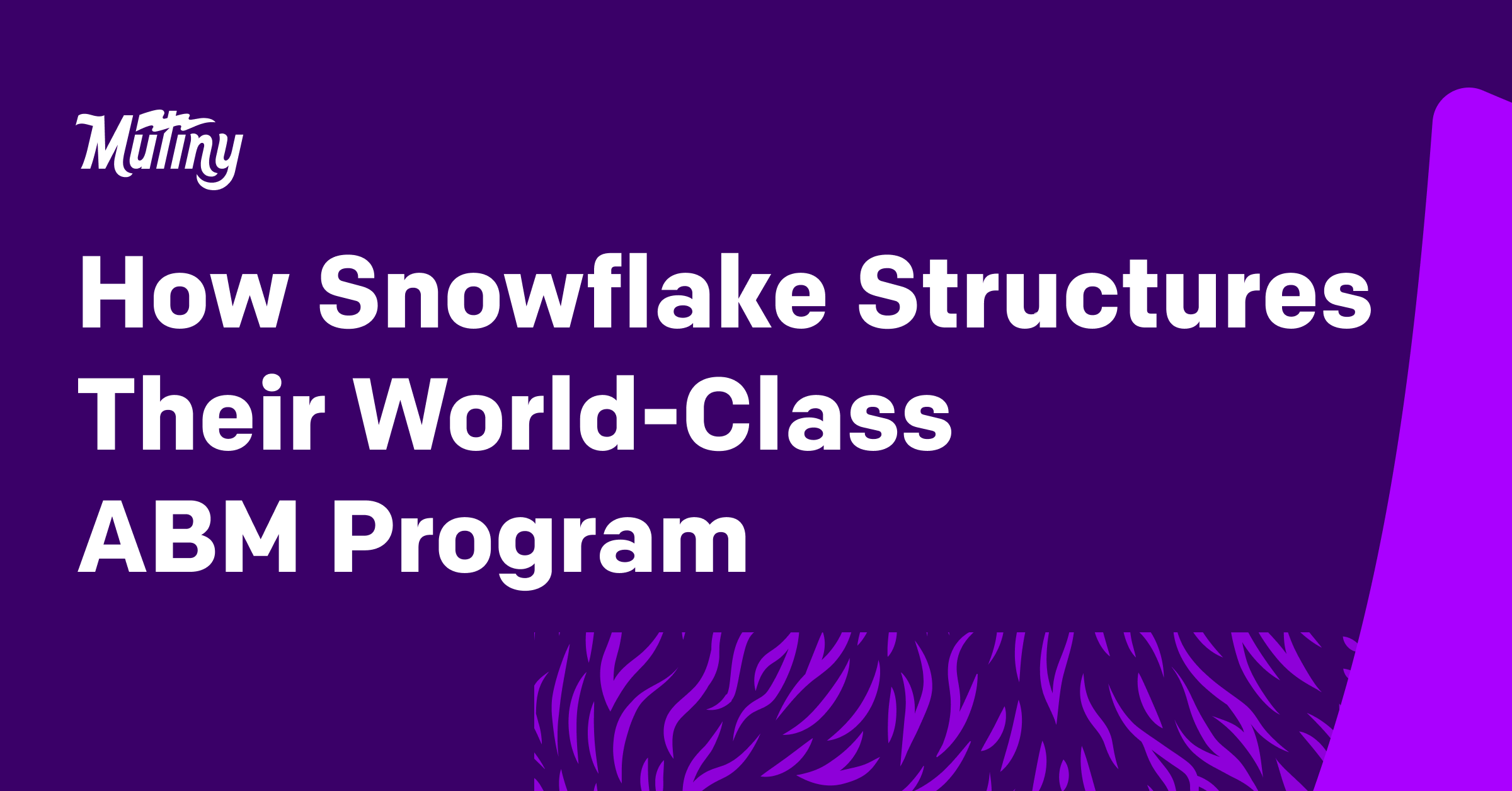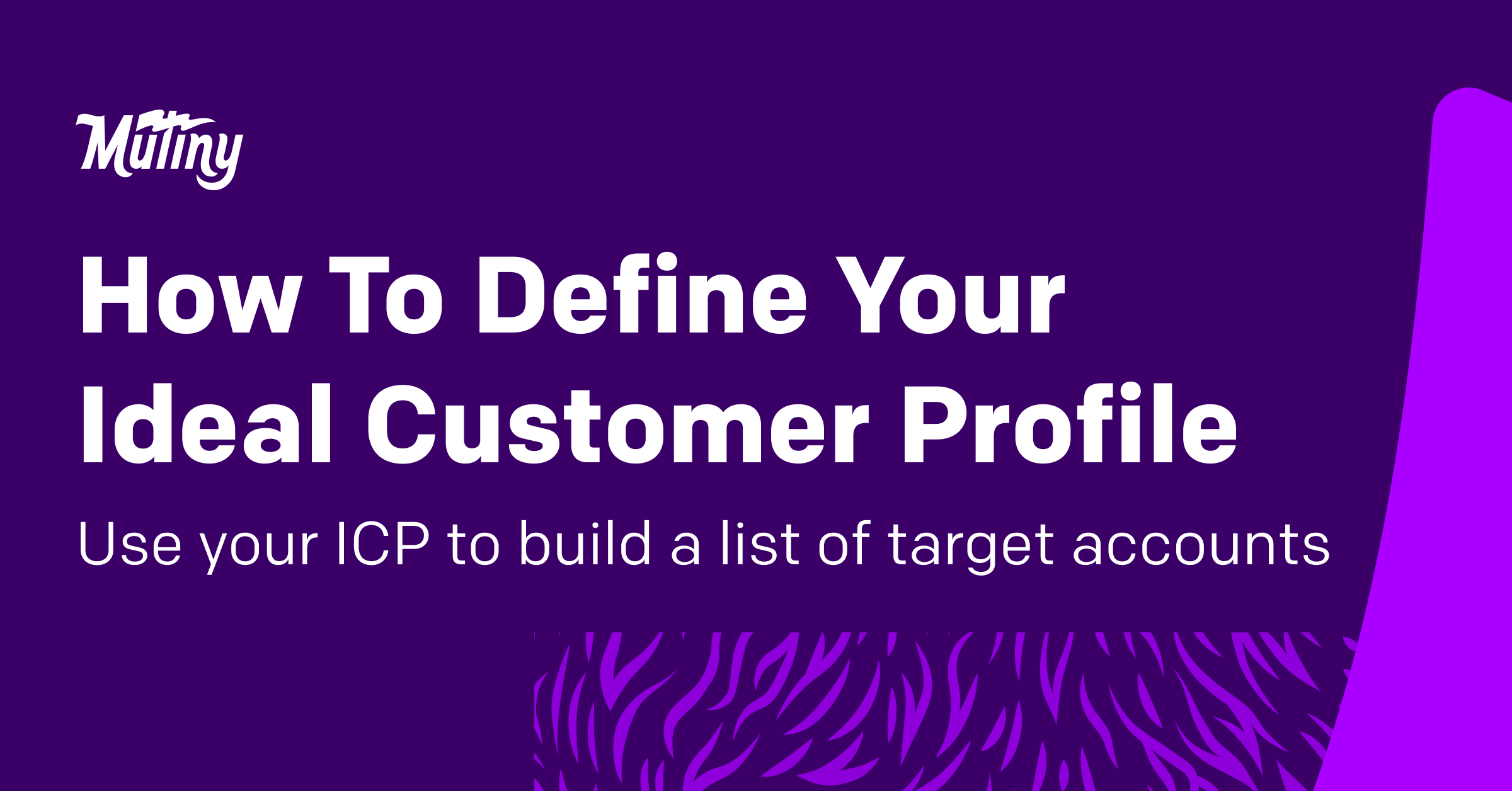- Product
- Content
- Customers
- Company
Want to get started?
See why companies like 6sense, Snowflake, and Amplitude use Mutiny to hit their pipeline goals.
Book your demo1:1 ABM personalization made easy
See how ABM teams use Mutiny to engage target accounts at scale.
See how Mutiny worksA strong go-to-market (GTM) program requires diversification. Why? Because many of the channels your GTM team is using, such as SEO, LinkedIn, and paid ads, are subject to algorithm changes and price swings. As your company grows larger, it’s too risky to rely solely on a single channel to generate all your pipeline.
To reach your target ideal customer profiles (ICPs) consistently and predictably, you’re going to want to consider what good old-fashioned outbound email can do for you (but with a modern twist, as you’ll soon see).
But generic mass outreach no longer cuts it, and will likely harm your brand in the long run. To truly connect with prospects, account-based marketing (ABM) strategies that prioritize personalization and multi-channel engagement are essential.
At Mutiny, the Business Development Representative (BDR) team has cracked the code on breaking into target accounts. By combining highly personalized microsites with coordinated cross-channel campaigns, they can generate 40% of the marketing team's pipeline. Liam Goldfarb, Mutiny's BDR Team Lead, pulled back the curtain and shared the innovative tactics his team is deploying.
Personalization: The Foundation of Effective Outreach
For Mutiny, personalization is the bedrock of our ABM strategy. Using Mutiny's own personalization capabilities, BDRs create custom-tailored microsites for each target account. When these personalized destinations are included in outreach emails, Liam reports seeing a 70% increase in open rates, driving 200% more revenue than without personalized pages.
But how do they uncover the insights needed to personalize at scale? Through a combination of customer interviews, AI-powered web scraping, and data enrichment tools. This allows the team to surface key details about an account's industry, business needs, and unique attributes. Armed with this intel, BDRs can craft hyper-relevant messaging that resonates.
"We group companies together into really tight buckets of what content is relevant to them," explained Liam. "We'll enroll contacts into email sequences based on their past behaviour. Then based on how they engage with the first sequence, they might qualify for two to three other sequences over the course of a month and a half."
By progressively profiling prospects and delivering personalized content that matches their evolving context, Mutiny BDRs keep the dialogue fresh and engaging throughout the buyer's journey.
Unified Messaging Across Channels Compounds Impact
Compelling personalization alone isn't enough. To maximize the impact, Liam works closely with Mutiny's ABM manager to orchestrate unified messaging across multiple channels. From outbound email campaigns, to paid ads, to the company's website experience - every touchpoint reinforces a cohesive narrative.
"We built this holistic journey," Liam emphasized. It starts with a prospect being "potentially unaware of Mutiny or at least not thinking about Mutiny." Then, through a sequence of interactions - "I've seen a paid ad. I've gotten a cold email outreach. I've been on their website. Now their website is personalized to me." - the BDR team steadily builds familiarity and interest.
Finally, Mutiny’s sales team capitalizes on the momentum with well-timed personal outreach.
By surrounding target accounts with consistent creative and messaging across channels, you can increase the odds of resonating with prospects. Each touchpoint builds on the last, compounding the impact.
Contrast this with disjointed campaigns where prospects receive mixed messages from a company's ads, website, and sales reps. Mutiny's harmonized approach is far more effective at earning a prospect's attention and trust.
A Culture of Experimentation Drives Continuous Improvement
Even the best campaign strategy must evolve. Prospects' preferences and behaviors change. What worked last quarter may not keep working. That's why Liam has instilled a culture of continuous experimentation and improvement in his team.
BDRs are encouraged to put their own spin on proven outreach tactics. "I would never get mad at one of my reps if they took my email copy and changed it," Liam stressed.
"Just because I was the first BDR and did it one way does not mean it should be done that way." This autonomy, combined with a scientific approach of A/B testing different subject lines and messaging, allows the team to rapidly evolve their campaigns.
To spark new creative ideas, Liam's team taps into insights from customer interviews and feedback loops. By identifying patterns in how prospects are responding, BDRs can develop original campaign concepts that are rooted in real customer needs and preferences. The best ideas are quickly adopted and rolled out across the team.
The Personalized, Multi-Touch Approach: A Winning Formula for ABM
By investing in personalization capabilities, coordinating unified messaging across channels, and relentlessly experimenting to uncover new best practices, Mutiny’s outbound ABM efforts cut through the noise and drive engagement.
This approach underscores the growing importance of hyper-personalized, multi-touch campaigns in the modern ABM landscape. Batch-and-blast tactics have lost their edge. Disjointed messaging across channels breeds confusion. The future belongs to agile teams like Mutiny's BDRs who can test, learn, and adapt their campaigns to fit the evolving needs of prospects.
Looking to take your own ABM program to the next level? Take a look at more ABM playbooks from companies like Snowflake and 6sense as they share the steps they take to build and grow their programs. But they all have some things in common; they embrace personalization, align their messaging across channels, and build a culture of experimentation.
The results will speak for themselves.
Share this Post
Learn to drive more pipeline
Curated resources to accelerate your career
Learn how top B2B marketers are driving pipeline and revenue.









